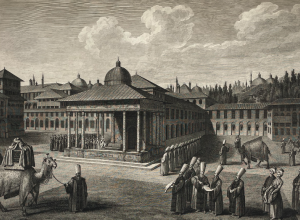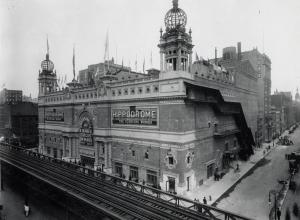“Collecting for the Boston Athenæum in the 21st Century” on Exhibit

(Boston, MA, March 26, 2014)—“This is a show about books and manuscripts that are visually appealing,” says Stanley Cushing, the Boston Athenæum’s Anne C. and David J. Bromer Curator of Rare Books and Manuscripts, of his exhibition “Collecting for the Boston Athenæum in the 21st Century: Rare Books and Manuscripts” (April 24 through August 9, 2014 in the Norma Jean Calderwood Gallery). “The focus is not on the text but on a beautiful image, illustration, or binding—a strong visual piece rather than something to read.”

The exhibition of more than forty works includes a broadside poster, two French bindings in bakelite from the early 1930s (“if you dropped that book, it would break,” Cushing says); a book on sailing yachts from 1890s Japan, a unique copy of Une Fille des Tropiques (Antilles [?]. 1927), inspired by the poetry of Charles Baudelaire and hand painted on wood from trees native to the Antilles; a copy of The Truest and Largest Account of the late Earthquake in Jamaica (London, 1693), bound in an elaborately engraved tortoiseshell binding; Henri Rivière’s Les Trentes-six Vues de la Tour Eiffel (Paris, 1888-1902), with its full-page lithographic illustrations of different views of the tower, influenced by Hokusai’s famous woodcut views of Japan’s Mt. Fuji; and Pierre Lecuire’s Cortège (Paris, 1959), with twenty-three brilliantly colored abstract plates designed by the Russian painter and printmaker André Lanskoy and produced in rich pochoir (a stenciling technique) by Maurice Beaufumé.
All of the works on view are “extraordinarily rare.” “‘Rare’ means not very many of them,” Cushing explains, “or they could be very valuable, they have very interesting previous owners, or unusual bindings. The show is a selection of a select view. This is the cream of the crop of everything I have bought since I have been curator.”
Cushing joined the Boston Athenæum staff in January 1971 and for many years headed the Conservation Laboratory. He became the Athenæum’s first curator of rare books in 2002. He was later appointed curator of rare books and manuscripts and became the Anne C. and David J. Bromer Curator of Rare Books and Manuscripts in 2012.
Cushing says he was “greatly influenced” by Philip Hofer, long of Harvard’s Houghton Library and legendary as a curator and collector of “great zeal and singular taste.” Hofer, who died in 1984, began collecting printed books as a teenager in 1917, eventually specializing in illustrated and decorated volumes. After a stint at New York’s Morgan Library, Hofer was invited to Harvard to establish Houghton Library’s Printing and Graphic Arts Department. As the department’s first curator, he spent the next forty years building one of the finest graphic-arts-in-the-book collections in the nation. He was also a proprietor and later a trustee of the Boston Athenæum.
Although Hofer was not on the Harvard faculty, he would, from time to time, take on students whom he would mentor in his field of expertise. Cushing was one of these. “He called me his ‘last student,’” Cushing says, “even though I wasn’t a student at Harvard. We met through my book binding teacher. Philip taught me how to look at books. We would have sessions examining manuscripts. He took me to England to meet with dealers. He was such a great expert himself, this became a one-on-one tutorial that went on for years. Seeing all those wonderful books with Philip taught me about important printers and binders.
“The reason I am curator now is that I worked for decades as a conservator at the Athenæum and knew where we had collected and where the gaps wear. I have worked on filling those gaps. We have built what is meant to be a didactic collection, to show to members, researchers, and staff. They are meant to be studied and all are available for examination and study.”
Mounting an exhibition of books meant to be examined in the hand presents certain challenges, Cushing says. “We have two French bindings from the 1930s that are very severe on the outside but they have absolutely fabulous art deco end papers. You open the book and they absolutely blast you. There’s also a two-volume set of one of the most elegant books ever, printed on vellum by the Doves Press and bound in blue Morocco by the Doves Bindery.”
Sometimes both the bindings and the interiors are visually interesting. That can present challenges for an exhibition. “Books will be in cases and some material framed on the wall with photographic details on the wall. We also have Cortège, a stunning French book that has never been bound. French editions gave collectors the option of binding or not binding but usually the English ones did not. The unbound book allows us to exhibit several sheets originally meant to be bound together.”
“Gaps” Cushing has filled in the Athenæum collection include “private press” books which are typically produced for private collectors in tiny editions, usually only a few hundred copies. “The Athenæum was not strong in private press books,” Cushing explains. “The Athenæum collected examples from the Kelmscott Press when they were coming out. I’ve gotten a few more.”
Among other private presses, Cushing added books from the Eragny Press, established in England by Lucien Pissarro, son of the Impressionist painter. These include a copy of Egrany’s The Little School with the stunning Pye binding, included in his show and previously owned by J. Paul Getty, Jr. “We had nothing from Eragny Press originally and now we have a world-class collection. On the other hand, I think it is important to try and not to duplicate things in other local collections. If a book is in the collection of the Boston Public Library or Harvard, for example, I generally won’t buy a copy for the Athenæum.”
After more than a decade in the job and four decades at the Athenæum, Cushing is well known to rare book dealers who often give him first refusal on things they think he would like to buy for the Athenæum collection.
“I remember one dealer from London who knew I liked a certain type of book. He told me he was coming to the United States and could he come up and see me? He arrived. He looked like Mick Jagger and he had one of those European men’s pocketbooks. In it was one book and I looked it over and I bought it. He said ‘thank you’ and he left. It’s very nice to get first refusal.”
About the Boston Athenæum:
Founded in 1807, the Boston Athenæum is one of North America’s oldest cultural institutions. The first floor of its National Historic Landmark building at 10 1/2 Beacon Street, Boston, including the Norma Jean Calderwood Gallery, is open to the public Monday, Tuesday, and Wednesday, 9:00 a.m. to 8:00 p.m., Thursday and Friday, 9:00 a.m. to 5:30 p.m., and Saturday, 9:00 a.m. to 4:00 p.m. There is a $5 admission fee for non-members to special exhibitions. Other public events at the Athenæum include exhibitions, lectures, readings, panel discussions, films, and concerts. For membership, events, and other information, please visit www.bostonathenaeum.org or call 617-720-7604.
Image: T. Sturge Moore, The Little School. London, 1905. Bound by Sybil Pye. Athenaeum Purchase, John Bromfield Fund, 2002.















